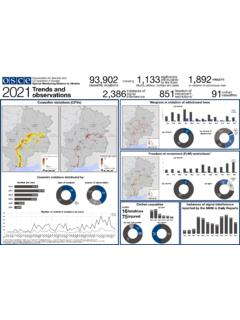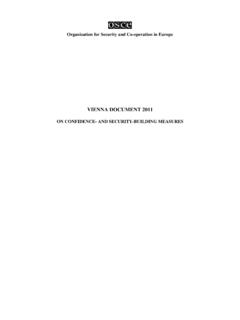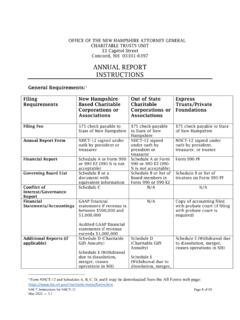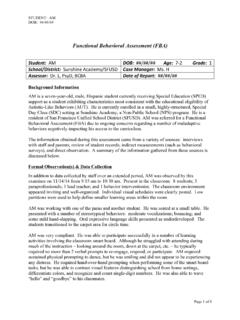Transcription of Preventing Terrorism and Countering Violent Extremism and ...
1 Preventing Terrorism and Countering Violent Extremism and Radicalization that Lead to Terrorism : A Community-Policing ApproachPreventing Terrorism and Countering Violent Extremism and Radicalization that Lead to Terrorism : A Community-Policing ApproachPublished by the Organization for Security and Co-operation in EuropeVienna, February 2014 OSCE 2014 Designed in Warsaw by HomeworkPrinted in Vienna by Stanzell DruckAll rights reserved. No part of this publication may be reproduced, stored in a retrieval system, or transmitted in any form or by any means electronic, mechanical, photocopying, recording , or otherwise without the prior written permission of the publishers. This restriction does not apply to making digital or hard copies of this publication for internal use within the OSCE, and for personal or educational use when for non-profit and non-commercial purposes, providing that copies be accompanied by an acknowledgment of the OSCE as the 978 92 9235 023 9 Transnational Threats DepartmentOSCE SecretariatWallnerstrasse 6, A-1010 Vienna, for Democratic Institutions and Human RightsUl.
2 Miodowa 10, 00 251 Warsaw, publication of this guidebook was made possible thanks to generous contributions from the Australian Government, through its Department of Foreign Affairs and Trade, the Swiss Confederation, through its Federal Department of Foreign Affairs, the United States of Amer-ica, through its Department of State, and the Principality of Liechtenstein, through its Ministry of Foreign Affairs. The content of this publication, including the views, opinions, findings, inter-pretations and conclusions expressed herein do not necessarily reflect those of these donors. It is not a consensus-based document. This guidebook is published in line with the mandate of the OSCE Office for Democratic Insti-tutions and Human Rights. The OSCE Secretariat does not accept any liability for the accu-racy or completeness of any information, for instructions or advice provided, or for misprints. The OSCE Secretariat may not be held responsible for any loss or harm arising from the use of information contained in this publication and is not responsible for the content of the exter-nal sources, including external websites referenced in this of Figures and Case Studies.
3 6 Acknowledgements ..9 List of Acronyms and Abbreviations ..12 Glossary ..13 Foreword ..17 Executive Summary ..191. Preventing Terrorism , Key concePts .. Preventing Terrorism as a Strategic Focus of Counterterrorism Efforts .. What Is Terrorism ? .. Strategic Approach to Countering Terrorism .. Accountability, Legitimacy and Trust in Counterterrorism .. Understanding VERLT .. What Is Terrorist Radicalization? .. Conditions Conducive to Terrorism .. Countering VERLT .. Criminal-Justice Aspects in Countering VERLT .. Addressing the Conditions Conducive to Terrorism .. Engaging with Individuals Drawn to VERLT .. Human Rights and Fundamental Freedoms Particularly at Stake in Preventing Terrorism and Countering VERLT .. Human Rights and Fundamental Freedoms in the Fight against Te r ro r i s m .. Freedom of Expression .. Freedom of the Media .. Freedom of Thought, Conscience and Religion or Belief.
4 Respect for Private and Family Life ..544 Preventing Terrorism and Countering Violent Extremism and Radicalization that Lead to Terrorism : A Community-Policing The Right to Peaceful Assembly and Freedom of Association .. Equality and Non-discrimination ..563. communIty-Based aPProaches to counterterrorIsm, Key concePts .. The Community Safety and Security Paradigm .. An Explanation of Community .. An Explanation of Community Cohesion and Community Resilience .. An Explanation of Community Security .. Communities and Counterterrorism .. Community-targeted or Community-oriented Approaches to Counterterrorism .. The Police and Communities as Part of a Multi-stakeholder Approach to Counterterrorism ..704. a communIty-PolIcIng aPProach to Preventing Terrorism and Countering verlt .. Basic Principles and Characteristics of Community Policing .. Community Policing and Preventing Terrorism : Strategy and Policy.
5 Community Policing as Part of a Comprehensive Solution .. The Interplay between Community Policing and Intelligence-led Policing .. How Community Policing Can Benefit Terrorism Prevention .. The Benefits of Engaging with the Police from a Community Perspective .. Minimizing Risks in Applying a Community-policing Approach to Preventing Terrorism ..895. ImPlementIng communIty-PolIcIng aPProaches to Preventing Terrorism and Countering verlt .. Transparency and Accountability of Police Operations .. Community Policing and Counterterrorism Operations .. Measures to Ensure the Human Rights Compliance and Accountability of Police Actions for Counterterrorism .. Tasking and Training for Community Police Officers .. Policies and Standard Operating Procedures .. Community Police Team Learning and Development .. A Five-element Model for Community Police Intervention .. Communicating and Exchanging Information with the Public.
6 Communicating with the Public on Counterterrorism .. Exchanging Information with Communities .. Engaging with Communities to Prevent Terrorism and Counter VERLT .. Parameters of Police Engagement with Communities .. Engaging with Specific Groups on Preventing Terrorism .. Engaging with Youth .. Engaging with Women .. Engaging with Faith-based Organizations and Religious Leaders .. Engaging with Ethnic Minorities .. Engaging with Civil Society Engaging with Small and Medium-sized Businesses .. Anticipating the Reactions of Members of the Public to Police Engagement .. Inter-agency Co-ordination and Referral Mechanisms .. Inter-agency Co-ordination between the Police and Other Public Authorities .. Institutionalized Referral Mechanisms for Individual Cases .. Evaluating the Impact of Community Policing Approaches to Preventing Terrorism and Countering VERLT ..1706. conclusIon.
7 178 Annex ..180 Bibliography ..187 List of Figures and Case StudiesFigure No. 1 Conditions conducive to terrorist radicalization in an individual case (page 38)Figure No. 2 Types of measures to counter VERLT (page 46)Figure No. 3 Examples of measures applied with a community-tar-geted or community-oriented approach (page 70)Figure No. 4 Example of the application of a SWOT analysis to lever-aging community policing as part of Terrorism -preven-tion efforts (page 92) Figure No. 5 Spectrum of public participation, International Associa-tion for Public Participation (page 128) Figure No. 6 Levels of engagement defined by the Committee on Ter-rorism of the International Association of Chiefs of Police (page 132)Figure No. 7 Examples of possible indicators to evaluate progress in achieving benefits of community policing in Preventing Terrorism and Countering VERLT (page 173) 7 List of Figures and Case StudiesCase study No.
8 1 Data mining, Germany (page 58)Case study No. 2 Stop-and-search powers, Spain (page 59)Case study No. 3 Promoting cohesion and reaffirming democratic values, public statements by the Prime Minister of Norway after the terrorist attacks of 22 July 2011, Norway (page 64)Case study No. 4 Dialogue Forum on Islam, Islamic Community and the Federal Ministry of the Interior of Austria, Austria (page 73)Case study No. 5 Police reform and community policing in Northern Ire-land, United Kingdom (page 81)Case study No. 6 Human rights and the Police Service of Northern Ire-land, United Kingdom (page 87)Case study No. 7 Community-policing efforts undermined by a controver-sial intelligence operation, New York Police Department (NYPD), United States (page 96)Case study No. 8 Simulation exercises on national security with commu-nity members, Royal Canadian Mounted Police, Canada (page 98)Case study No.
9 9 Community Policing and the Prevention of Radicaliza-tion (COPPRA) Project, European Union, Belgium (page 108)Case study No. 10 The Integrated Security Management Matrix, North Holland, the Netherlands (page 110)Case study No. 11 The Plan Vigipirate national Terrorism alert system, France (page 113)Case study No. 12 No surprises policy of the Police Service of Northern Ireland, United Kingdom (page 115)Case study No. 13 Dedicated press- and media-relations capacity within the police on counterterrorism, Finland (page 117)Case study No. 14 Information exchange and community-tension monitor-ing, United Kingdom (page 120)Case study No. 15 Police public outreach through social media, Estonia, Finland and the Netherlands (page 123)Case study No. 16 Police preventive talks with young people at risk of VERLT, Sweden and Norway (page 136)Case study No. 17 National Security Youth Outreach Program of the Royal Canadian Mounted Police, Canada (page 137)Case study No.
10 18 Youth engagement initiatives of the Diyarbak r Police Department, Turkish National Police, Turkey (page 139)Case study No. 19 Pizza with a Peeler programme, Police Service of North-ern Ireland, United Kingdom (page 141)8 Preventing Terrorism and Countering Violent Extremism and Radicalization that Lead to Terrorism : A Community-Policing ApproachCase study No. 20 The Shanaz Network, engaging women in Prevent , United Kingdom (page 145)Case study No. 21 Project Schnittmengen , Islamic Centre and district police of G tersloh, Germany (page 147)Case study No. 22 Diversity Education and Law Enforcement Outreach Pro-gram of the American-Arab Anti-Discrimination Com-mittee, United States (page 152)Case study No. 23 Society Democratic Culture , Germany (page 155)Case study No. 24 Centre for Information on Destructive Subcultures, Fryshuset, Sweden (page 158)Case study No. 25 Project Griffin, City of London, United Kingdom (page 159)Case study No.















